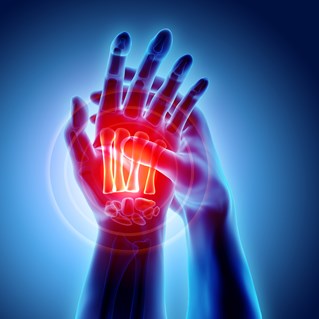
Carpal Tunnel Syndrome (CTS)
What is carpal tunnel syndrome (CTS)?
The carpal tunnel is a tunnel in your wrist through which nine tendons (these control the movement of your fingers and thumb) and a large nerve (median nerve) pass. Over the front of the wrist there is a ligament and this forms the roof of the tunnel. The floor of tunnel is formed by the carpal bones. When the median nerve becomes irritated or squashed within this tunnel this is called Carpal Tunnel Syndrome (CTS). CTS is a common hand condition and is referred to as a “compressive neuropathy”.
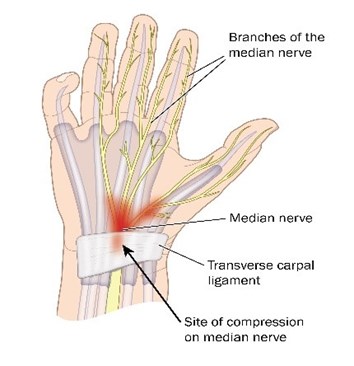
Diagram 1: Picture of the Site of Compression for Carpal Tunnel
What are the symptoms of CTS?
The main symptom of CTS is altered feeling in the hand, often felt or described as pins and needles and/or numbness. Pain can also be felt but this is usually less common. The median nerve gives feeling to the thumb, index, middle and the thumb side of the ring finger. This is why people who have CTS normally feel their symptoms more so in these digits.
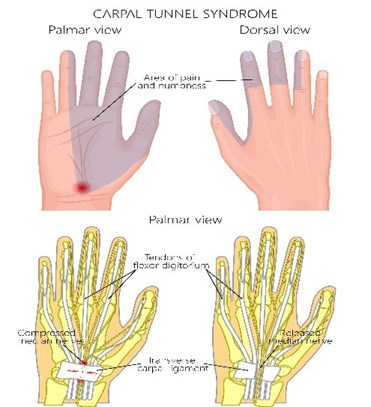
Diagram 2: Picture of Where Altered Sensation for Carpal Tunnel Occurs
The symptoms experienced with CTS can often be felt more so;
- At night (sleep can be disturbed)
- First thing in the morning
- Carrying out activities which involve gripping (for example, holding the phone, driving and reading).
In more severe cases the altered feeling may become more continuous. There may also be weakness and wasting (loss of muscle bulk) at the base of the thumb. In advanced or severe cases, some patients with CTS may describe a feeling of clumsiness and/or find they are dropping objects easily. The majority of people with CTS have much milder symptoms that come and go but these rarely affect the ability to carry out activities involved with daily living.
How common is Carpal Tunnel Syndrome?
- Carpal Tunnel Syndrome (CTS) is a common condition of the upper limb.
- About 7%-11% of the population will experience CTS symptoms at some point in their lifetime.
- CTS is three times more common in women than men.
- CTS can occur at any age and occurs in both men and women but most commonly affect women in middle age.
What causes it?
- In most people, the cause of Carpal Tunnel Syndrome is not known.
- Anything that reduces the space within, or increases the pressure within the Carpal Tunnel, can potentially lead to symptoms of Carpal Tunnel Syndrome.
- Factors that have strong evidence supporting an increased risk of Carpal Tunnel Syndrome include, obesity or being significantly overweight.
- Other factors that have been associated with an increased risk of Carpal Tunnel Syndrome include:
- Overuse of the hand and wrist such as in gardening or renovating a house, activities requiring forceful grip/exertion (evidence on an association between computer work and Carpal Tunnel Syndrome is variable)
- Osteoarthritis and rheumatoid arthritis
- Wear and tear in your tendons or inflammation of your tendons
- Hypothyroidism
- Diabetes
- Wrist trauma
- Pregnancy
Tests for Carpal Tunnel Syndrome
Nerve conduction
Usually the diagnosis of CTS is made of the basis of your story about your symptoms. Symptoms of CTS tend to follow certain patterns and most patients report similar things. Examining the hand is helpful too. Most patients with CTS will find the splint and exercises in the following section helpful. This information can help to confirm, or exclude, the diagnosis and explains why patients are often encouraged to try this first.
Some patients require electrical tests called nerve conduction studies. This is often because the diagnosis is in doubt or because you have diabetes. These tests can provide some evidence to confirm the CTS diagnosis and the level of severity.
Blood tests
Some conditions can cause symptoms similar to CTS, or make the symptoms of CTS worse. This is known as peripheral neuropathy. Therefore, your health care professional may request that you have simple blood testing to check for diabetes and to check that your thyroid, folate and Vitamin B12 levels are within are normal limits.
Carpal Tunnel Syndrome – myths vs facts
Myth 1 Everyone with Carpal Tunnel Syndrome needs an operation
Fact 1 The symptoms of Carpal Tunnel Syndrome can settle on their own. Many cases settle with simple treatment or advice. If your symptoms do not settle with simple treatment or advice other treatments are available but not everyone will require these treatments.
Click HERE for a printable version of this section
What splint should I wear?
The correct splint can be a very effective tool for helping your symptoms.
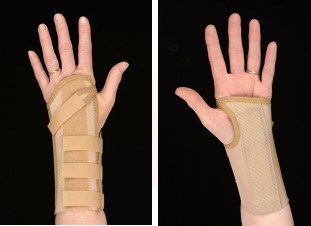
Diagram 1: Picture of a Futuro Wrist Splint
A wrist splint can be worn so that the wrist is kept in a straight position at night for mild CTS symptoms. It can take some time before significant relief is experienced.
The splint should be worn for up to three months at night whilst sleeping, by which time you will be able to decide whether it has helped in a satisfactory manner or not.
If the splint was helpful and allowed your symptoms to settle, it is useful to store it in a clean, dry place. Should your symptoms ever return, you may wish to use it again a short time.
How to wear and look after any splint you have been given
Wearing Instructions
- Straps should be applied firmly, but not too tight.
- Wear liners under splint for hygiene/comfort.
- Your splint is to be worn overnight in bed.
- Your therapist/health care professional will alter this wearing regime when appropriate.
Precautions
Contact your therapist for a splint adjustment if you experience the following:
- Rubbing
- Increased pain
- Skin irritation
- Red marks lasting longer than 20 minutes
- Increased swelling
- An increase of, or new, ‘pins and needles’
- Colour changes to your skin
Care of Splint
- Hand wash in cold soapy tap water: Remove metal/plastic bar prior to washing. Rinse thoroughly and dry in shade.
- Splint liners may be washed more regularly in cold, soapy tap water.
Click HERE for a printable version of this section.
Excercise
These exercises can help relieve CTS symptoms by gently gliding the median nerve and tendons through the carpal tunnel.
1. ‘Tendon Glides’
The following exercises have been suggested as being helpful in improving the movement of the tissues in and around your wrist. Learn the sequence of moving through positions one to five. Once you have learned the sequence, this should be repeated 10 times. Aim to do these exercises little and often throughout the day for example, three or four times a day.

Diagram: Tendon Glides
2. ‘Median nerve glide; arm’
- Hold your arm out to the side with your elbow bent, your palm facing up and the wrist extended back.
- Straighten the elbow and hand three quarters of the way
- Go between the two positions
- Repeat five times, five times per day
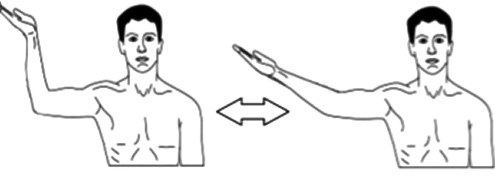
Diagram: Median Nerve Glide – Arm
3. ‘Median nerve glide; wrist’
- Bend your wrist down (flexion) and back (extension). Keep your fingers relaxed.
- Keep your elbow still whilst you do the exercise
- Repeat the exercise 5 times
- Do this 5 times per day

Diagram: Median Nerve Glides – Wrist
Please Note:
- It is normal to feel mild discomfort that lasts for a short time after your exercise. However, if you feel an increase in your pain or symptoms you should stop that exercise until you talk to your health care professional.
- Your exercises are an important part of recovery and will only help if you do them as instructed.
- This information is intended as a general guide only, if you have any further questions please ask your therapist.
Neurodynamic
Exercise 1 – Median Nerve Glide
To do this exercise – have affected arm out at side to shoulder height with palm facing up towards the roof. Side flex neck and then rotate head to look down towards the floor. Then flex and extend your wrist.
Do for 30 second, repeat several times per day.
Click HERE for a printable version of this section.
Other treatments – general advice
n many patients, symptoms from Carpal Tunnel Syndrome can come and go for some time before either settling down or becoming a problem. If there is an underlying cause such as diabetes, thyroid disease, pregnancy, or even menopause in women, then treating this condition may help resolve symptoms.
Carpal Tunnel Syndrome due to pregnancy will often get better after the baby is born.
Steroid injection
A single/one off steroid and local anaesthetic injection can be effective in select cases; for example, during/after pregnancy, where surgery cannot be undertaken safely, or when the patient opts not to have surgery.
Steroid injections work by reducing any inflammation within the Carpal Tunnel but not everyone with CTS is suitable for a steroid injection. Splints are easier to use, known to be beneficial and have less side effects than steroid injections. This is why you are often encouraged to try this before other, more invasive treatment options.
Click HERE for more information on corticosteroid injections.
Surgery
In some patients with CTS where the symptoms are severe or deteriorating, surgery may be considered. Usually this would be after the splint, advice and exercises have been tried and have failed to help. Surgery remains the most effective, proven long-term solution to Carpal Tunnel Syndrome. The operation involves cutting the ligament over the front of the wrist to ease the pressure on the nerve. The surgery is routinely done under local anaesthesia as a day case procedure.
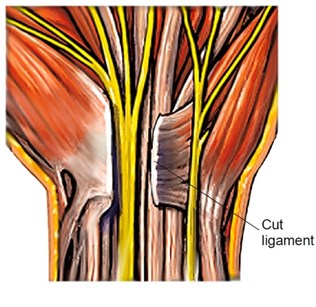
Diagram 4: Picture of Carpal Tunnel Decompression
Surgery usually cures the problem. Night pain and tingling usually disappear within a few days. In severe cases, constant numbness and muscle weakness may be slow to get better or may not fully resolve. Occasionally pain can be felt over, in and around the wrist after surgery. It generally takes about three months to get back full strength and a comfortable scar. The hand can be used for light activities from the day of surgery.
Although surgery is a relatively safe and effective option with there is a price to pay. Some patients find their grip is decreased, feel uncomfortable putting pressure over the scar and feel their scar can be initially be quite sensitive. These symptoms normally settle after a few weeks but can take longer in some patients.
Overall, the results of open Carpal Tunnel decompression are excellent with around 96% of patients reporting good outcomes at one year. There are risks involved with all surgery, however, and you can read more about these risks by following the link below.
Click HERE for more information on hand surgery